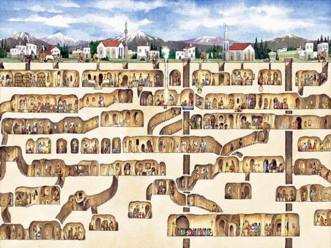Subterranean
The subterranean
environs down below,
deep but not dank,
underneath all within these depths
where darkness once crept,
keeps underground stores for food,
the only peril now would be flood.
Down from up man switched his gaze,
traded lanterns for the light of day,
to not feel that heat,
to gain respite from the noise of feet.
Dead souls do not linger here,
this is a place with much life
impersonating majestic night,
where man found grand room for such grand rooms
as danger up above them loomed.
Solemn not the norm here in this glad place
And voices boom, no gallery of tombs
or cells for those who don't move.
This subterranean space,
well below the darkling skies and stars,
by edicts of kings and will of man dug.

Derinkuyu
Derinkuyu is the largest excavated underground city in Turkey, one of hundreds of underground complexes found across Cappadocia. The region's name was perhaps derived from the Hittite "katta peda-" (place below). In Nevşehir Province, it extends to a depth of approximately 60 m (200 ft) and is large enough to have sheltered as many as 20,000 people together with their livestock and food stores and contained wine and oil presses, stables, cellars, storage rooms, refectories, and chapels. The city was used as protection from Muslim Arabs during the Arab–Byzantine wars (780-1180) and was connected with other underground cities through miles of tunnels. They continued to be used as protection from the Mongolian incursions of Timur in the 14th century, and after the region fell to the Turks they were used as refuges from the Muslim rulers. As late as the 20th century the locals, called Cappadocian Greeks, were still using the underground cities to escape periodic waves of persecution.
ReplyDelete